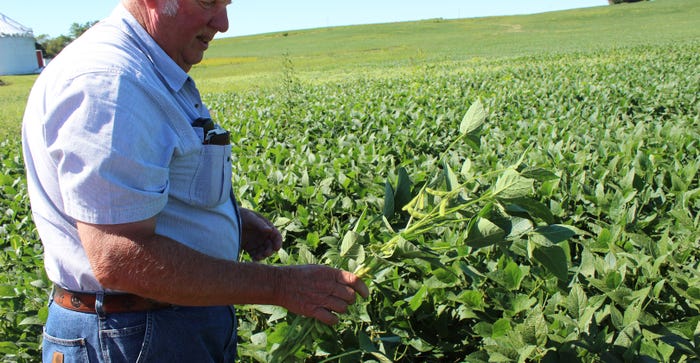
All spring, the rains kept soaking Keith Dennis’ fields. And as May stretched into June, he realized he just wasn’t going to be able to plant his 600 acres as he had planned.
That’s a familiar story for Ohio farmers in 2019. But for Dennis, the year of prevented planting was 2011, when his farm seemed to catch every wet weather system that rolled through Perry County. Now, eight years later, Dennis is still farming, but he’s not farming the same way he was before that challenging year. He reevaluated his production practices and found ways to reduce his production costs and rebuild his soils with cover crops and no-till. “There’s no way I’d go back to tilling,” he says.
In the years leading up to 2011, Dennis had been using conventional tillage and high rates of fertilizers in an effort to maximize yields. In 2008, 2009 and 2010, he had repeatedly increased his horsepower so he could till deeper to break up his hard soils. “This farm got so hard, it was like tilling this concrete,” he says, pointing to the floor of his farm shop. Looking back, he recognizes the damage he was doing with so much tillage. “Every time we tilled, we were losing carbon and killing our biology,” he says.
Regenerating soils, cover crops
Dennis was looking for better options in 2011, when he went to a field day in April and heard a presentation by Ray Archuleta, who was then a soil conservationist with the Natural Resources Conservation Service. One example Archuleta gave helped Dennis visualize how soils can regenerate.
Archuleta asked the group to think about their concrete sidewalks — and why they constantly had to clean grass and soil off the top. The explanation, Archuleta told the group, was that the soils were growing. Dennis pictured a concrete walkway on his own family farm that had soil pushing up over it from each side. In contrast, soil in a 2-acre plot he had been tilling intensively for production of dried flowers was shrinking away lower than the surrounding land.
Later that spring, after he’d given up getting his corn planted, Dennis planted his fields with a cover crop of Austrian winter peas and radishes. By the next spring, he says, he could already see improvement in his soil. “It made a lot of difference — just that one time,” he says.
In the years since, Dennis has continued using no-till and cover crops to protect and improve his soil. He previously was following a two-year rotation, raising all corn one year and soybeans the next. Now, his rotations include fall-planted cover crops after both corn and soybeans. He has also raised some oats and cereal rye for seed.
Dennis has used a variety of cover crop species and mixes. In the spring, he plants green into living covers and has been burning them down with herbicide. He plans to switch to rolling the cover crops to crimp and kill them after planting spring crops.
Each spring, Dennis waits to plant until the soil is 55 degrees F, after May 15. With the later planting, he is able to kill some weeds along with the cover crops, he explains.
Better soil structure, drainage
Dennis says he’s seen constant improvement in his soil structure. Previously, he needed a shovel to loosen the soil surface so he could get a probe into the ground to take soil samples. “Now, I can take them with one hand,” he says.
His wife, Janie, is seeing improvements in the soil as well. Since they began using cover crops in her garden, the soil has become looser and easier to hoe.
Dennis also sees an improvement in field drainage. “Before covers, I’d have puddles everywhere,” he recalls.
When farmers see drainage problems, they should consider the history of a field. New problems with drainage may be related to declining soil health, in which case adding more tile isn’t the solution, he explains.
“If you didn’t need it in the past, why do you need it now?” In one of his fields, he had considered adding additional subsurface drainage lines between the existing lines spaced at 50 feet. However, he waited to see what a cover crop of tillage radishes and peas would do, and he no longer sees the need to install the additional tile.
Less fertilizer, non-GMO seed
Along with his adoption of cover crops, Dennis has scaled back his use of added fertilizer and selects non-GMO seed without expensive traits to keep production costs low. His yields are lower, too, but profitability is better, he says.
For instance, in 2016 his cost per acre for corn seed, herbicide and fertilizer was $115. He grew an average yield of 140 bushels per acre; so after paying for seed, fertilizer and herbicide, he ended up with $400 to $500 per acre to pay other production costs and still make a profit. “It sure takes the pressure off,” he says. He’s also investigating the possibility of earning a premium for his non-GMO crops.
Dennis stresses that his transition to using cover crops has not always been smooth. He’s seen problems with herbicide residuals, and in the fall of 2018, he was not able to plant his cover crops due to the wet fall weather.
Any farmers who are shifting to cover crops should expect to do some experimenting to find what works for their individual farms, he adds. “You can’t throw it out if you have a hiccup.”
Keck writes from Raymond, Ohio.
About the Author(s)
You May Also Like




